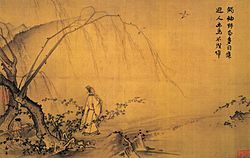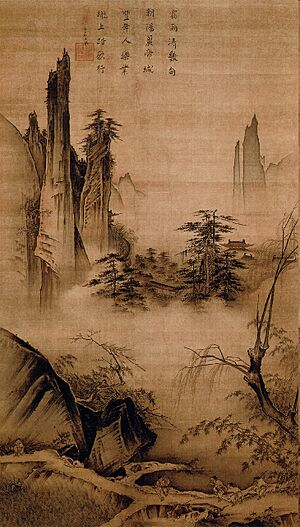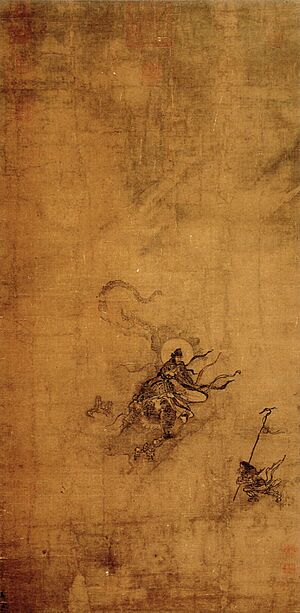Ma Yuan (painter) facts for kids
Quick facts for kids
Ma Yuan
|
|
|---|---|

Walking on a Mountain Path in Spring
|
|
| Born | c. 1160 |
| Died | 1225 |
| Nationality | Chinese |
| Known for | Painting |
|
Notable work
|
Dancing and singing Walking on a mountain path in spring |
| Movement | Southern Song Dynasty, Ma-Xia movement |
Ma Yuan (Chinese: 馬遠; pinyin: Mǎ Yuǎn; Wade–Giles: Ma Yüan; around 1160–65 – 1225) was a very famous Chinese painter. He lived during the Song dynasty in China. His artworks, along with those of another artist named Xia Gui, created a special style. This style was called the Ma-Xia school of painting. Their work is thought to be some of the best from that time. Ma Yuan's paintings inspired many Chinese artists. They also influenced great early Japanese painters like Shūbun and Sesshū.
Ma Yuan's Life Story
Ma Yuan was born in a city called Qiantang. Today, this city is known as Hangzhou in Zhejiang province. He came from a family of artists. His great-grandfather, Ma Fen, was a painter for the emperor's court. This was in the early 1100s.
Both his grandfather, Ma Xingzu, and his father, Ma Shirong, also worked as painters for the court. They served the Southern Song emperors in Hangzhou. After the year 1189, Ma Yuan also became a painter for the emperor. He worked for Emperor Guangzong.
Ma Yuan was very well-known and respected at the court. Emperor Ningzong especially liked his paintings. The emperor even wrote poems inspired by Ma Yuan's art! We don't know much more about his life. Ma Yuan passed away in 1225. His son, Ma Lin, also became a painter for the emperor. He was the last artist in their family.
What Did Ma Yuan Paint?
Ma Yuan was a very skilled painter. He could paint many different things. But he is most famous for his beautiful landscape paintings. These were often long scrolls showing nature scenes.
At first, his painting style was similar to another artist named Li Tang. But Ma Yuan soon developed his own unique way of painting. He added special decorative touches. For example, people at the time said his pine trees looked "strong as if they were made of iron wire."
One special thing about many of his paintings is the "one-corner" style. In these pictures, the main subjects are placed in one corner or on one side. This leaves a large part of the painting empty. It creates a feeling of space and quietness.
Besides landscapes, Ma Yuan painted many other types of art. He created delicate flower paintings. Some of these are now in the National Palace Museum in Taipei. He also painted a series of water and mountain scenes. These are kept in the Palace Museum in Beijing.
Ma Yuan also painted pictures of Zen masters. Two of these are in a temple called Tenryū-ji in Kyoto, Japan. Many small album leaves (single pages from an album) are thought to be by Ma Yuan. However, it's hard to be sure about all of them. This is because he was so popular that many other painters copied his style.
Walking on a Mountain Path in Spring is one of the album leaves that we know for sure is by Ma Yuan. It is in the National Palace Museum. Two other leaves are in the Museum of Fine Arts in Boston. Another is in a private collection in Cleveland, Ohio.
A few long hand scrolls by Ma Yuan also still exist. One of his most important works is The Four Sages of Shangshan. This painting is in the Cincinnati Art Museum in Ohio. Ma Yuan is also remembered for something interesting in the history of science and technology in China. He was the first artist to show a fishing reel in his artwork. You can see it in his painting called Angler on a Wintry Lake.
Images for kids
See also
 In Spanish: Ma Yuan para niños
In Spanish: Ma Yuan para niños




